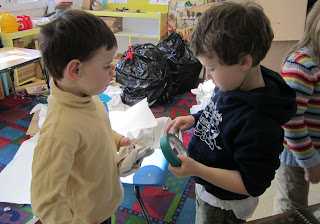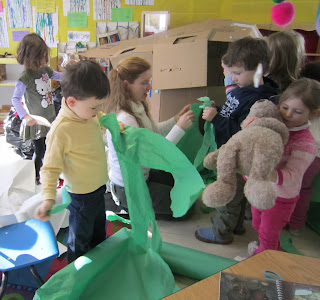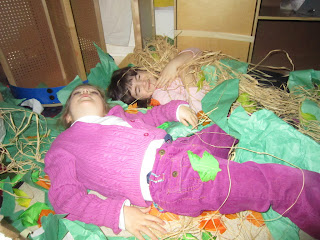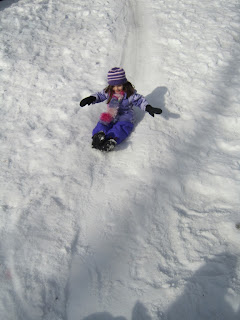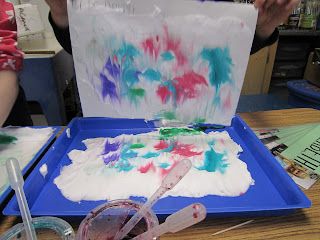Just read an article in the New York Times about parents being upset with the amount of artwork that they have to deal with from their children. I find this a very sad state of affairs and am so grateful anytime a self created piece of work comes home from my children now that they are in elementary, middle and high school.
In the comment section, there was a great suggestion for storing artwork. Find it on the ohdeedoh website.
I do not save everything my children create. I do save pieces that they are particularly proud of, or that show a developmental milestone. I try and involve them in the process of choosing. I also take photographs of their projects if they are particularly meaningful. This works well with dioramas and clay pieces. The other way we deal with this issue, or I should sadly say, dealt with, is to give them to relatives. We turn them into presents, cards and gift wrap when possible.
And remember, the biggest focus should always be on the process. "Did you enjoy making that?" "Tell me how you made that?" "What made you think of that?"
As I look at my kitchen bulletin board full of tests and essays, I am longing to have this problem back.
Musings on how children learn best through play and The Project Approach in action
Thursday, January 27, 2011
Learning Through Play in a Bear Cave
One of the most important components of the project approach/emergent curriculum with young children is dramatic play. As explained in a great book I have been reading, Young Investigators-The Project Approach in the Early Years, “young investigators often show what they know through their play. …As children represent roles using the props, they show the depth of their knowledge of the topic as well as their understanding of the roles of adults (or animals in our case) regarding the topic. …The teacher can extend the opportunity for children to show what they know by participating in the play group. In this way, objects can be requested by name, and the teacher can give specific items to children to see how they are used and to take note of the vocabulary they have already mastered.”
This week we put this in place by creating a bear cave in our classroom.
On Monday the children helped us remove our regular props of dress up clothes, food, dishes and babies. We then took large cardboard boxes, cut them apart and laid them over the furniture securely attaching them with duct tape. The children helped with all the kinds of tape they could find around the room.
We talked about the size of the entrance to the cave and decided to cut it out in the front. Then we had to do some problem solving as the scissors were not working.
We ended up using one of the saws from our workbench.
Then we made some rocks for the front of the cave. This became quite the effort in team work as children crunched paper and tried to tape the rock balls with masking tape.
Some children did some research to find out how bears create the insides of their caves. We made some grass by ripping green paper to line the inside of the cave.
The next day we painted the outside of the cave and added more bedding. This time we added sticks and twigs (paper towel rolls), animal hair (raffia) and leaves.
Of course we had test it out along the way.
A great deal of problem solving is occurring while these bear cubs vie for personal space.
Once in the cave, they decided they needed food. We went back to the books to research what the bears store in their caves (if anything) and found out that they will keep a stash of nuts and berries if they can. A few cubs went off to make food.
When we were finished, I joined in the play as Momma Bear. We read about how the bears snuggle up to keep warm, so that is just what we did. It was a lovely, quiet time inside the cave talking about bears.
When it was time to clean up for the day, I realized that one of my little bear cubs had actually fallen asleep on my lap. Now that is how you study hibernation!
Monday, January 24, 2011
Learning Through Snow Play
We are experiencing a wondrous winter here in Connecticut. We actually have snow-and lots of it. It is easy to send our children outside to play in the snow. Children of all ages, from preschoolers to teens, will happily spend hours engaged in such play.
But is there value in having kids play in the snow other than the benefits of fresh air and time away from the TV? Absolutely! An in-depth look at what children are learning gives greater value to the experience.
Snow play requires creativity, scientific observation and negotiation skills. Think of the creativity fostered as children build snow creatures and use various objects to decorate them. They learn the complexities of problem solving as they try to mold snow into different designs. Adventurous types learn about construction and the properties of physics as they try to build jumps for sledding or walls for snow forts.
When friends play together, they learn social skills needed for negotiation as they develop the rules for snowball fights or come to understand how to take turns while sledding. Kids learn self-control while they wait for their chance to fly down the hill, or hide out for the perfect shot. These are not rules that are taught to them from a skill book or basketball practice; they are spontaneously created by the group, and are likely to be internalized on a much deeper level than through books, parents and teachers.
This is play in its organic form; experimenting, discovering, problem solving, negotiating, and creating all wrapped up with the emotion of joy.
This is the play that will give them the skills needed to be successful adults.
Harvard professors Erika Christakis and Nicholas Christakis say something similar. In a recent article on CNN.com, “Want to get your kids into college? Let them play”, they write “one of the best predictors of school success is the ability to control impulses. Children who can control their impulse to be the center of the universe, and—relatedly—who can assume the perspective of another person, are better equipped to learn.” They continue to explain that “through play, children learn to take turns, delay gratification, negotiate conflicts, solve problems, share goals, acquire flexibility and live with disappointment. … Academic achievement in college requires readiness skills that transcend mere book learning. It requires the ability to engage actively with people and ideas. In short, it requires a deep connection with the world.”
In the overly scheduled scramble of daily living that is the current norm, it is easy to be lulled into thinking that we give our children plenty of play opportunities. Our children are on sports teams and in dance classes and have every electronic gadget advertised on TV—complete with “educational” games. However, this is not the play that will develop these particular social and problem solving skills.
When a child is on a baseball team, she is learning a finite set of rules and skills. Yes, this is an important kind of learning. Nonetheless, when there is a situation on the field, the umpire and coach are responsible for deciding how it will be handled.
Conversely, in a snowball fight, the children develop the rules and consequences as the play evolves through negotiation and trial and error.
A recent article in the New York Times, “Effort to Restore Children’s Play Gains Momentum” by Hilary Stout, describes the impetus for many parents and professionals to get behind the play movement. “Much of the movement has focused on the educational value of play, and efforts to restore recess and unstructured playtime to early childhood and elementary curriculums. But advocates are now starting to reach out to parents, recognizing that for the movement to succeed, parental attitudes must evolve as well-starting with the willingness to tolerate a little more unpredictability in children’s schedules and a little less structure at home.”
It can be quite difficult. As I try and write this, my children, ages nine, twelve and fourteen, are home and stuck inside due to an ice storm. It would be so much easier, not to mention neater, if I would allow them to sit in front of the television rather than pull out all of the art materials that I did. It would be even easier for me to put a stop to the fact that my son has created a catapult using kitchen utensils and is investigating how far his clay creations can sore through the kitchen, but I keep reminding myself of the incredible learning that is taking place.
As parents, we need to embrace spontaneous moments of creative play. Not only that, we need to create the time and space for them to occur, which may require putting aside routines and our comfort levels for noise and mess. While doing so may not be easy, it is well worth it for the powerful message we tacitly send to our children as to the value of this type of activity.
Still, I sure do wish my son could go play in the snow right now.
A shorter version of this post appeared in TheDailyNorwalk.
Friday, January 21, 2011
Snow Play
We have been having so much fun with all of the snow blanketing Connecticut these days.
Yesterday was perfect for making snow creatures. We tried the rolling ball method and found that too difficult for the fours. Then I showed them the shovel method where we made a huge pile of snow and then carved out our creature-who made her way in to being a girl eventually.
The other passion of my students has been sledding. We have a wonderful hill on our playground.
We didn’t supply sleds, so they used their creativity with the help of a fun loving dad and began sledding down on our plastic shovels.
Although this was closely monitored, the handles caused some concern, so we brought out plastic trays.
We brought out three trays and have 16 children, so they are getting an excellent opportunity to practice their self control and patience as they wait for a turn.
It was great fun!
I hope you are getting your students outside every day. We go out twice a day unless it is below 22 degrees. It did take some parent education on the necessity of proper snow clothes including waterproof boots, gloves/mittens and snow pants. It also takes an extra dose of patience as a teacher to help dress and undress 16 children. They are all getting much more independent with all this practice.
Aside from the wonderful learning opportunities, the squeals of delight from the students make it all worth it!
And one more thing…
Allow yourself to have some fun WITH them!
Chloe’s chants of Da-na! Da-na! led to this…
Thursday, January 13, 2011
A simple project leads to an exciting discovery!
With emergent curriculum deciding on what topic the children are interested enough in can be the biggest challenge. This year has been one of the more difficult years in this regard and we have spent a great deal of time in ordinary moments exploring materials in various ways.
And then, it happens.
Last week a mom came in to class with her family tradition of making pinecone birdfeeders. Each child made a feeder and we hung them on the bushes and trees on the playground. When we returned the next day, many of them were gone and we found tracks in the snow. We followed the tracks and tried to determine the animals that had made the tracks. The children became fascinated with this endeavor and made incredible predictions. This was the impetus for many questions about which animals actually live around our playground. Could it really have been a llama?
We are fortunate to own a set of animal footprint molds, so when we went inside I quickly changed some of the plans for the day. I pulled out the molds and our playdough and we investigated making prints in the dough and comparing them to each other and to what we had seen in the snow.
I pulled out a book about animal tracks that we had in our library and read that with the children. They were eager to share all they “knew” about tracks and animals. I helped them to form some of these thoughts into questions and we began our new web.
Each day following this initial discovery, most children would rush to the site upon arrival to search for more tracks. We talked about how we would learn more about this topic and they decided that we needed more books, and to watch out the window and to talk to an expert.
Thus, many of my initial plans were scraped for the week and changed to follow this new path of discovery. Now my behind the scenes work begins. What experiences can I plan to help them answer their questions?
I have learned from some other great blogs, such as Playful Learning about making casts of animal prints. We are making another animal feeder this week using orange halves which will hopefully entice more wildlife to make prints on their way to the feast.
I was able to get to the library and gather books about tracks and the various animals the children thought would live near our playground. I will also be calling our local nature centers to schedule a trip to talk to a naturalist.
I would love your ideas for following this exciting topic.
Playfully Yours,
Dana
Note: Due to the severe allergies of some of the children in my room, we were not able to use birdseed. We used sunflower butter, dry cereal (without oats) and dried fruit.
Thank you for letting us get dirty, mom and dad!
A huge thank you to the parents of my students for all the laundry they happily do!
They truly understand that “a dirty kid is a happy kid!”
They may smirk when they say, “oh, I am so glad that I have to wash these mittens again this week!” because they are covered in liquid watercolor from painting the snow or mud from cooking in our outdoor kitchen.
However, they do know the value of the play that their children are engaged in while getting dirty.
They never send their children to school in clothes that cannot get covered in glue, paint, mud, sand, glitter, playdough and other sticky concoctions.
It is so important that we allow children the gift of deeply exploring materials; and this may mean with full hands, or arms or even feet.
Teachers, if you are not getting the same positive response you may need to take time to explain to your parents exactly what is being learned in experiences like these and actually talk about the type of clothes children should be wearing to your program.
I even have some parents who, in the Spring especially, arrive at pick up time with a change of clothes because they have learned that their children will be too dirty or wet to get in to their clean cars.
So, thank you, parents, for understanding the importance of getting dirty!
Playfully Yours,
Dana
Calling Joyful Teachers!
I love what I do. I find great joy in coming to work every day and feel very passionate about teaching.
I know so many of you feel the same way.
My colleague, Patricia Reinhardt, and I have begun work on a book about finding happiness and joy in teaching. In order to lay a foundation for our work, we need to gather information from a wide variety of teachers. If you would be interested in being part of our research by completing a survey, please contact me and provide me with your email address. We will then send the survey to you.
Please pass this along to other teachers you think may be interested.
We are looking forward to hearing and learning from you!
Email me at dgjasonsmom@gmail.com or leave a comment following this blog
Wednesday, January 5, 2011
Shaving Cream Art
My creative colleague, Clara Cohen, shared a really cool art experience that we are playing with this week.
Spray a tray with shaving cream.
Have children flatten it with scrapers.
The children drop droplets of liquid watercolor onto the shaving cream.
Once they have all the color they want, the children swirl the shaving cream using a toothpick.
Then take a piece of paper with the child's name already written on it (we had them write names first before getting their hands full of shaving cream) and lay it on top of the shaving cream.
Gently pull it off and scrape the shaving cream off with a tongue depressor.
The color stays! It is a vibrant, colorful painting that is beautifully interesting.
Most importantly, the process is fun each step of the way!
Tuesday, January 4, 2011
Christmas Eve Dinner Recycled in Class
My mom is Italian. Every Christmas Eve she make a huge fish dinner. This year, it was literally a HUGE fish dinner. The whole sea bass came in an enormous styrofoam box.
Now what my husband sees as more trash...I see as a wonderful learning center!
I brought the box into school, set out some wooden sticks and a few wooden hammers and the children have been loving pounding the "nails" into the box.
I assumed they would leave it flat and pound only from the top. But young children never cease to amaze me. They like to hold the box upright, so children on one side are pounding the sticks in and at the SAME TIME, children on the other side are pounding the sticks that have already been pounded- out!
The cooperative play and problem solving, not to mention the fine motor work that this one box is providing is amazing.
Almost as amazing as my mom's dinner.
Now what my husband sees as more trash...I see as a wonderful learning center!
I brought the box into school, set out some wooden sticks and a few wooden hammers and the children have been loving pounding the "nails" into the box.
I assumed they would leave it flat and pound only from the top. But young children never cease to amaze me. They like to hold the box upright, so children on one side are pounding the sticks in and at the SAME TIME, children on the other side are pounding the sticks that have already been pounded- out!
The cooperative play and problem solving, not to mention the fine motor work that this one box is providing is amazing.
Almost as amazing as my mom's dinner.
Snowball Bullseye
Children love to throw snow. That can become a problem, especially when the little spheres of white are actually hard as ice (as they are on our playground right now).
One of things I always try to think about is..."how can I say YES to this?"
 So, in order to say, yes! to snowball throwing, I made a bullseye on each of our chalkboard shed doors. That way many children can throw snowballs. They have incentive to throw it at a target rather than each other.
So, in order to say, yes! to snowball throwing, I made a bullseye on each of our chalkboard shed doors. That way many children can throw snowballs. They have incentive to throw it at a target rather than each other. And..if a snowball does get thrown at a child, it is easy to redirect, "Oops, that's not where we throw snowballs, go throw it at the bullseye!"
Both children usually happily head off to target practice.
Young children hear, "no!" or "don't!" so often. Think about what your students and children are doing or want to do...and find a way to safely say, "yes!"
Our snow is not white!
The playground is so much fun covered in snow.
One of our favorite things to do after we’ve enjoyed the new fallen snow and it starts to get packed down, is to add some color.
We fill spray bottles with watered down liquid water color and pass them out to the children.
They have a ball spraying the snow and looking at all of the different colors on the ground.
Then they get creative…
Today a few girls made a beautifully decorated birthday cake for a friend.
Some other children were busy putting their scientific minds to work as they watched the effects of the spray of water on the fence, through the fence, down the slide
and on the rocks.
Simple spray bottles and some color add so many learning opportunities to our outdoor snow-covered classroom.
Grab some and go play!
Subscribe to:
Comments (Atom)




